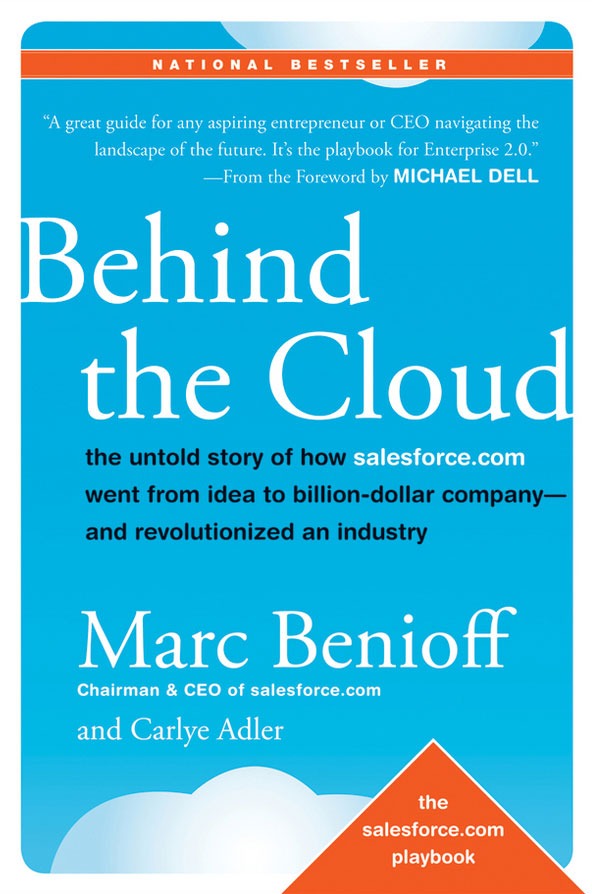Behind the Cloud Summary
11 min read ⌚
MicroSummary: Marc Benioff is regarded as the father of the software industries as a service and cloud computing. His company, Salesforce.com, is simply the biggest success case of setting up a company that has made $ 1 billion in revenue in just 10 years. Behind the Cloud reveals how Benioff took a new idea, a powerful concept from paper, and differentiated himself from his competitors by creating a whole new movement where users no longer need to install software on their computers. The software is always available, on-demand, in the cloud.
A well-known quote – For success, all you need to have is the right approach.
“Behind the Cloud” emphasizes the importance of a winning mentality, but is it the only aspect you should pay attention to? – Of course not.
We summarize the book’s content and draw a conclusion, that you as an entrepreneur will find breathtaking.
Who Should Read “Behind the Cloud”? And Why?
Behind the Cloud is ideal for wannabe entrepreneurs and especially people already engaged in SaaS. As it encourages people to think outside of the box and to take matters into their own hands.
If the market desires a particular product, you should immediately change or upgrade your existing one. If you continue being stubborn your business will suffer in the long-run.
Marc Benioff also talks about one particular truth – The customers have no understanding of your troubles if you fail to give them what they want they’ll look elsewhere.
About Marc Benioff & Carlye Adler
 Marc Russell Benioff is an American-born writer, philanthropist, entrepreneur, founder and CEO of Salesforce.
Marc Russell Benioff is an American-born writer, philanthropist, entrepreneur, founder and CEO of Salesforce.
He was born into a Jewish family on September 25, 1964, in San Francisco, California.
Benioff started developing apps at a young age; he sold his first app for 75 dollars.
He obtained his bachelor’s degree from the University of South Carolina. Currently, his wealth is estimated at approximately 4.5 billion dollars.
Most of his wealth comes from Salesforce of course. In 2006 BusinessWeek placed Salesforce among the first “Top 100 Most Innovative Companies” in the 21st century.
 Carlye Adler is an award-winning journalist and a writer of several best sellers.
Carlye Adler is an award-winning journalist and a writer of several best sellers.
“Behind the Cloud Summary”
Find out how Salesforce managed to conquer the world by becoming a billion-dollar Company so quickly? The Founder of Salesforce Marc Benioff shares his secrets with the readers in this unique, enthralling tale.
Within ten years, Salesforce grew so much and reached the financial heaven.
From an internet start-up company operating in a one-bedroom located in Telegraph Hill, San Francisco, to a global leader with estimated annual revenues of over $1 billion U.S. dollars.
This American cloud computing company has had an unbelievable impact on the world economy and business community because Salesforce was the first ever dot-com company to participate and trade on the New York Stock Exchange.
Salesforce shows no signs of stopping.
Stay with us for more on Salesforce drawn from “Behind the Cloud”:
The company continues to spread its influence as a philanthropic leader among businesses by making valuable donations to its core business practices.
Many companies use Salesforce as an exceptional model, Google and other international companies have supplied their communities and continue to do so with plenty of donations.
These gifts come in different forms: free products, money, talent, and support.
Salesforce realized that it is vital to redefine customer relationship management (CRM) applications – and the entire company’s application industry – designed for the 21st century.
Salesforce possessed and still does a clearly defined vision; this transparent perspective provided different businesses with software in a surprisingly efficient way: digital, without experiencing any installation complexities, software maintenance issues, and annoying upgrades.
What to expect:
“Behind the Cloud” is a magnificent book, the founder, and CEO Marc Benioff and Carlye Adler(Journalist) speak about Salesforce’s fascinating and quirky story, from the very beginnings- start-up challenges and difficulties to its worldwide expansion and success.
It is not a regular thing – told entertainingly, the authors break this unique tale into a series of valuable business lessons, meant to educate readers from different cultures.
You are probably familiar with the name Michael Dell – (the founder of Dell).
Here’s the best part:
He and Stephen Boedagrees declared that Adler and Benioff’s new volume is “the perfect playbook for Enterprise 2.0 and not only entrepreneurs but the entire world can learn from this book”.
Business leaders will probably change their working habits and define new long-term objectives as soon as they become more familiar with Salesforce’s instructive history.
Back in the 2000s when Salesforce revenues increased, many companies and business analysts realized that Salesforce influence is increasing globally, encouraged by the current situation Salesforce set up its European head office in an ancient Irish castle to gain respect.
Key Lessons from “Behind The Cloud”
1. The Start-Up Playbook’s vital characteristics
2. Don’t limit yourself, solve problems and become productive
3. Trust your intuition and don’t rush to answer critics
The Start-Up Playbook’s vital characteristics
The internet’s power and potential were Benioff’s inspiration to start its own business.
That approach led him to discover a Salesforce cloud computing company.
In the late 20th century, Marc successfully launched his new business using several essential strategies, including:
Don’t limit yourself, solve problems and become productive
Salesforce’s fascinating and unique concept: use cloud computing services to provide different companies with the best software.
Benioff resolved the company’s constant problem – paying a large sum of money to technicians for maintaining a company’s hardware by offering them high-quality customer resource management (CRM) applications available on the web.
Trust your intuition and don’t rush to answer critics
At first, Benioff faced some unexpected skepticism and pressure about his start-up project.
He even heard the word “a crackpot idea” from Dave Moellenhoff – web developer.
However, Benioff strongest attribute was his calmness; this criticism didn’t have any effect on him.
A good entrepreneur always gives logical, detailed reasons that explain the company’s method of working.
The irony is that Moellenhoff, later on, became one of his co-founders and financiers of this project.
Like this summary? We’d Like to invite you to download our free 12 min app, for more amazing summaries and audiobooks.
Our Critical Review
“Behind the Cloud” is a fascinating book, in our opinion.
However, it might lose a bit of its relevance as the reader proceeds with exploring the book’s secrets.
Especially the first few chapters are fact-filled, and information full for individuals who are eager to leave a mark in the business world.
| NEW / Extended | Behind The Cloud Summary
Believe In Your Ideas And Execute Incessantly
Benioff’s secret to putting Salesforce’s plan into action is simple. According to him, just focus on and execute the idea you believe in, even if it means going against the crowd.
The concept of Salesforce.com emerged after Benioff spent years as Oracle’s Vice President and decided to leave the company to take a well-deserved vacation and understand the new dynamics of the market.
The category of CRM (Customer Relationship Management) was something new until then, and the leading company in the segment was called Siebel. Siebel’s product allowed salespeople and account managers in large companies to control contacts, and information about their customers and manage potential opportunities.
However, there are some problems. The system was extremely expensive. It needed a lot of maintenance and similar to contemporaneous software, it needed to be installed on the customer’s computer, inside the company where he/she worked.
Benioff thought he could improve CRM software by using a software-as-a-service concept (something the industry prefers to call Software as a Service or SaaS) through cloud computing, that is, without requiring software installation on the client’s computer.
With the idea in mind, Benioff sought to talk to Tom Siebel, founder of Siebel Systems, who, while sympathetic, did not believe that it could conquer a significant part of the market and become profitable.
That’s why Benioff, focused on his idea, decided to start Salesforce alone. He knew he had to think big and recruit the best programmers for his new company.
For Benioff, Salesforce represented “the end of current business models and software technology.” He knew that this reference would intrigue a good developer and help attract the best talent.
So he was able to hire highly experienced application developers, who worked with him in a tiny apartment in San Francisco.
Marketing From Day 1
Promoting a new product is a way to grow fast when you are still a startup. Salesforce.com bought a huge fight with the market leader as if their business was the new market leader since Day 1.
Salesforce was Anti-Siebel, for proving unique and adopting a new distribution model. Wherever he went, Marc was spreading the good news of the future of CRM systems and quickly caught the eye of the Wall Street Journal, who wrote a cover story on “The Birth of a New Industry “.
Benioff knew that he had to offer a clear message to the media about how Salesforce.com was different from other companies.
Salesforce.com needed a motto, a slogan, and for that, Benioff hired Bruce Campbell, a legendary advertiser who created the “NO SOFTWARE” logo cut by a red line.
Not all programmers liked the idea, but Benioff felt that his concerns were needless as the logo soon spread in newspapers and magazines and the campaign was recognized as one of the best of the year. The logo represented a big battle.
On the one hand, there was Salesforce and the media pointing to the end of the traditional software era and on the other, the industry giants.
Marc bought a big fight with Siebel, staging a protest over the end of traditional software at the Siebel user convention.
All participants of the event saw the action, which was covered by the media.
The protesters were also invited to the SF software launch party, which featured a mega-band, the B52’s.
Bet On Events To Create A Community
One of the first marketing strategies adopted after Salesforce launch was to take advantage of event promotion to build a community around the brand.
For Benioff, the best marketing strategies that result in more sales are news stories, containing unbiased reviews in the mainstream media and customer testimonials, that is, the word-of-mouth, enthusiastic about their success stories.
Already in its second year, Salesforce began organizing a tour in several US cities, with keynote presenters, customer presentations, and demonstrations.
That brought together potential clients, journalists and analysts, curious to know what the “NO SOFTWARE” movement was.
This end-user meeting made a big difference in the company’s marketing success. Traditional software companies went after executives who, while controlling budgets, were less likely to use the product to convince them.
Salesforce.com found it better to work with real customers with its potential. They held events filled with interesting content and fun and relaxed parties at the end.
The result was the impressive conversion of 80% of those present into business opportunities.

The Client Always Comes First
Business software from the pre-Salesforce era was complex, difficult to use, and the negotiations took months to materialize. Salesforce did not believe in this model and wanted their customers to feel the product before buying.
They should evaluate before buying, so SF started offering free product testing through their website.
The first version of the software cost $ 50 per user per month, and the free trial greatly reduced the risk to the customer.
To ensure product quality constantly improved, SF also created an exclusive area for customers to identify problems and communicate them to the company so they could be corrected quickly.
With this customer feedbacks, they were able to avoid rework and refine the software immediately, unlike the traditional software installed on clients’ computers.
With the bursting of the .com business bubble, a crisis that has affected most Internet companies, Salesforce has lost many customers, and this has created serious capital problems.
The great solution for the company was to change the collection model from monthly to annual.
With this change, more than 50% of new customers agreed to migrate to advance payment, and within 1 year the company became profitable by retaining most of its customers.
This was only possible because they had gained the trust and loyalty of their customers long before and the same customers now felt confident in advancing the payments.
SalesForce Scalable Product Model
Salesforce’s biggest innovation was to create a product that shared its infrastructure with all other customers and allowed for great cost savings.
Traditional software companies like Oracle or Siebel had a different product running on each user’s computer within the company.
Salesforce’s mission was to create a flexible product that could be used by all its customers, even in different ways.
Each customer could perform their different tasks with their own data in one product.
There were never two versions of the Salesforce system running and that greatly increased its efficiency. In the beginning, the traditional companies did not bet on the model or believed that it could work.
But this was actually a big advantage for SF because maintenance and new software updates were automatically installed for all customers.
They were actually creating a world “WITHOUT SOFTWARE” or at least without infinite software installations on the client’s computer.
The Salesforce product was simple and prioritized speed and ease of use. If the features were simple, bug fixes and system speed would be good.
However, for customers not to be frustrated and create their own system variations, SF created its application platform, which allowed customers to create their own resources directly from the servers in the cloud.
This flexibility greatly increased the possible utilities, further increasing the potential market for Marc Benioff’s small CRM startup.
Each Market, A Culture
Salesforce.com now dominated the US market, but as the need for CRM software adoption was gaining the world, Marc Benioff was eager to expand overseas.
Salesforce.com opted for Europe to get started and, to have a promising start, started out in Dublin, Ireland.
At this time Dublin was attractive to large companies like Oracle due to the English-speaking population and the favorable tax rate of only 12.5% (In Brazil it can reach 27.5%!). They also decided to hire only natives from different countries.
So when a customer from England called they would think they were speaking with an English person.
Although they had a simple, functional office, they conducted meetings in most of London’s luxury hotels to demonstrate their SaaS software.
Using hotels for meetings created a picture of success for their clients, and was cheaper than renting traditional offices.
The company quickly began to adapt its marketing strategy to different markets.
Salesforce’s aggressive marketing strategy was extremely effective in the United States and Europe, so now they set out to reach Asian markets, starting with Japan.
After conducting a simple survey, they recognized that they needed to approach Japan with a slightly different positioning.
Japanese companies are traditionally cautious about foreign products and are looking for products known in Japan.
To have their first sales, they had to air some references to other growing companies which the Japanese were more familiar with, such as Google or Amazon.
When the biggest Japanese companies started using Salesforce.com on a daily basis, many other business owners decided to follow suit.
Family And Friends. They Can Help You Finance Your Ideas
In the early days of Salesforce, no investor was enthusiastic about the “no software” concept. Benioff, however, focused on pursuing his idea and remembered large companies such as Starbucks and Cisco, which were also dejected by investors.
Benioff went after those who believed in him: his family and friends.
To his surprise, he found many people in his immediate circle who fully supported his idea. He managed to raise $ 65 million to fund his growth using these tactics.
In 2002, Salesforce.com was aiming to become a $ 1 billion company, and they decided to open their capital.
However, as the market still had memories of the bubble burst of .com ventures, companies now needed to demonstrate significant revenues.
Taking the opposite direction from the conventional, Salesforce.com began an audit before the public offering of shares to the market, called IPO (or initial public offering).
After more than a year of internal preparation in 2003, Salesforce.com increased its annual revenue from $ 25 million to $ 100 million.
It is more than double what other companies had achieved. In 2004, it entered the stock market to become the most successful software-as-a-service company in history.
Final Notes:
Salesforce.com is a great reference for anyone who wants to start their company in the cloud and selling to other companies, the B2B market.
Its marketing and sales machine and its excellent products have created the largest SaaS company in the world.
12min tip: If you liked this successful case from Salesforce, how about knowing another successful case of a SaaS company?
Check out our microbook of The Hard Thing About Hard Things and see the trajectory of Ben Horowitz at the helm of Opsware!
Emir is the Head of Marketing at 12min. In his spare time, he loves to meditate and play soccer.







